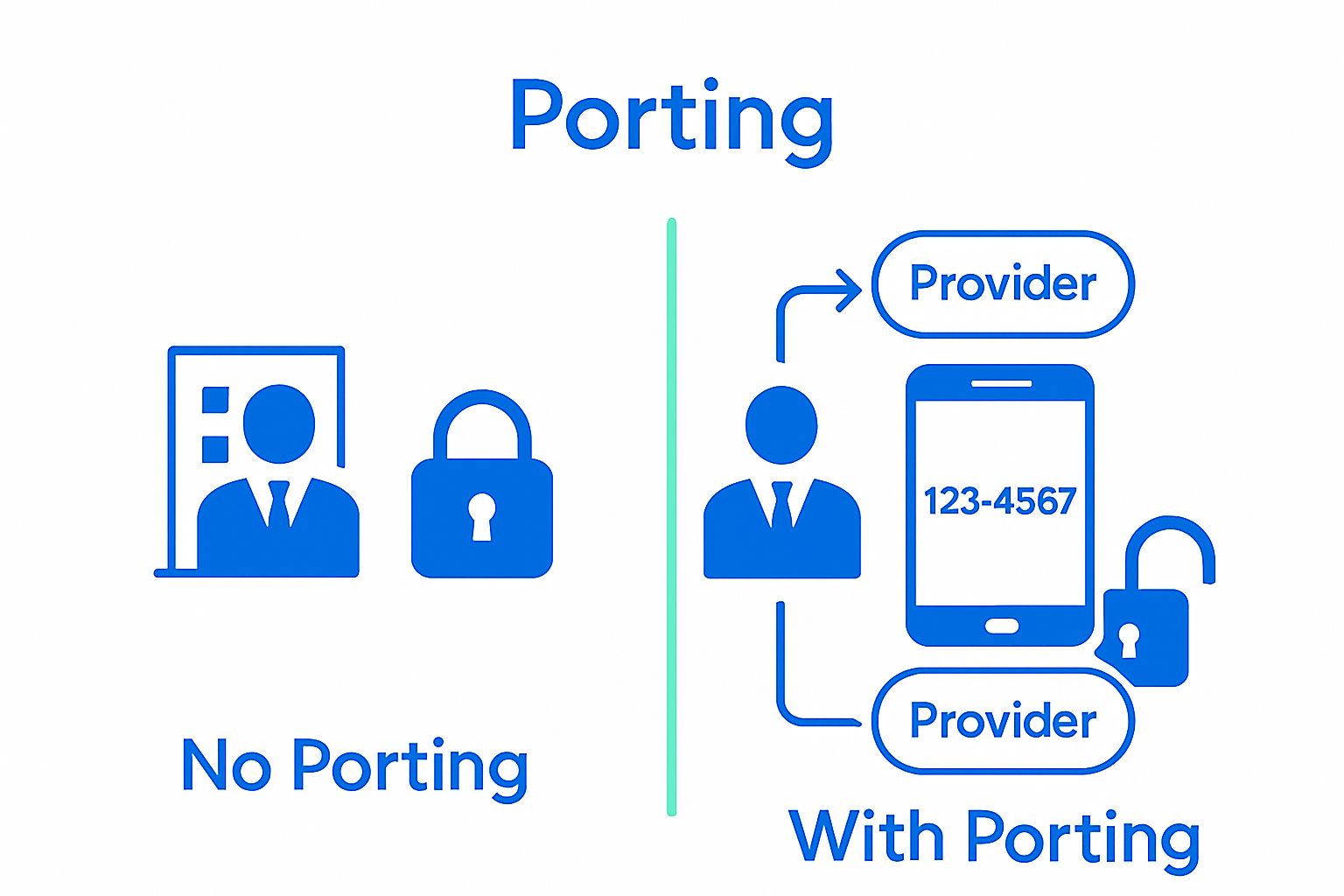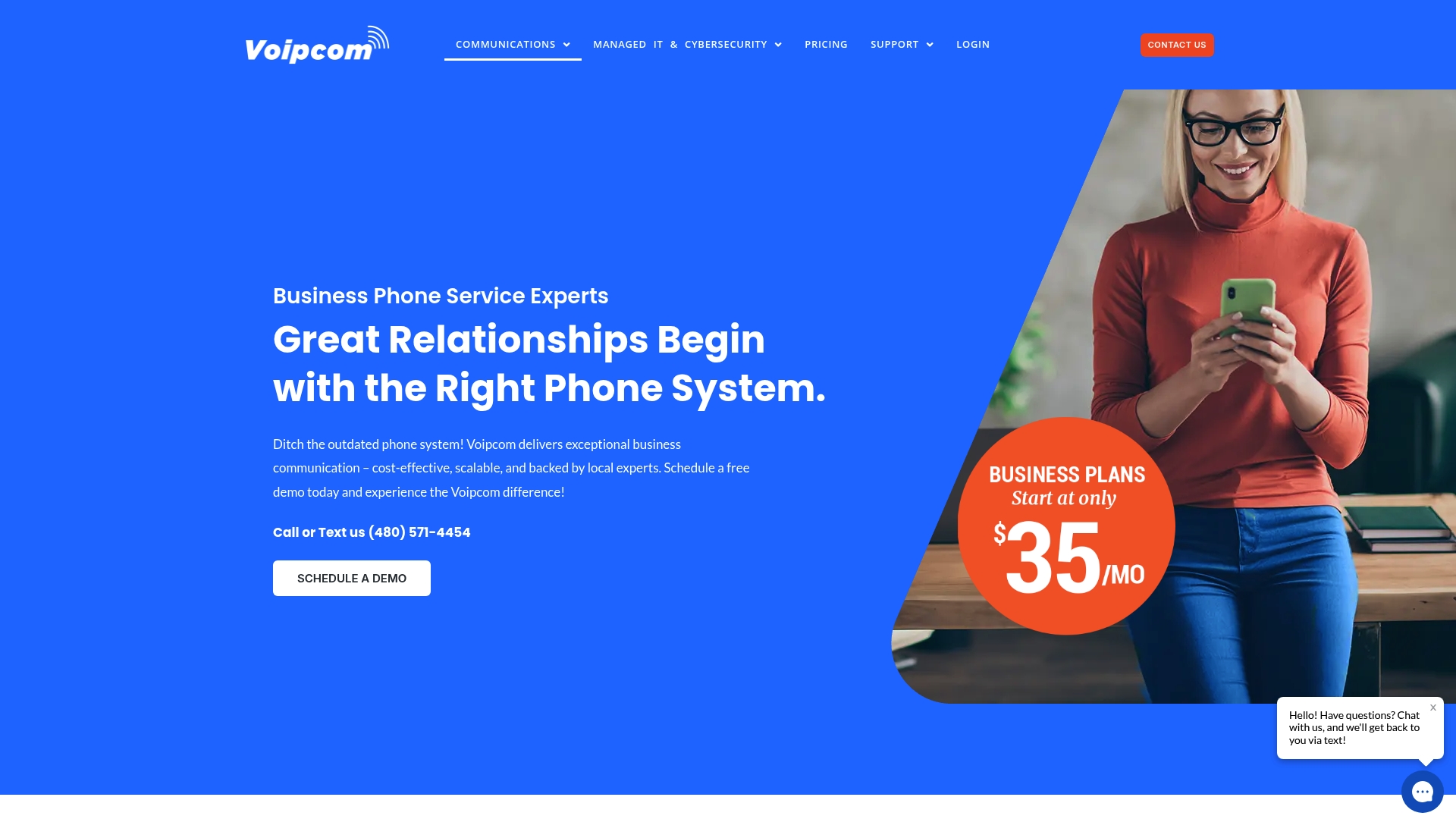Switching phone carriers used to mean losing years of recognition tied to your old phone number. Now, more than 100 million Americans have kept their number after changing providers, showing how number porting is transforming the industry. It is not just about keeping digits, it is about protecting your identity and freedom no matter where your service comes from.
Table of Contents
- Defining Phone Number Porting And Its Purpose
- The Importance Of Phone Number Porting For Businesses
- How Phone Number Porting Works: The Basic Process
- Regulatory Aspects And Key Concepts Of Porting
- Real-World Applications And Benefits Of Phone Number Porting
Quick Summary
| Takeaway | Explanation |
|---|---|
| Phone Number Porting Allows Flexibility | It enables individuals and businesses to switch providers without losing their established contact number. |
| Maintains Brand Consistency | Companies can retain their phone number through service changes, preserving customer trust and recognition. |
| Cost Savings on Communication | Retaining phone numbers eliminates costs related to rebranding and updating marketing materials when switching carriers. |
| Consumer Empowerment in Selection | Users can choose telecommunications providers based on quality and pricing rather than being locked into a number. |
| Regulatory Protections Ensure Smooth Transitions | Consumer rights are safeguarded by regulations that mandate timely and secure number transfers between providers. |
Defining Phone Number Porting and Its Purpose
Phone number porting represents a fundamental telecommunications process that empowers consumers and businesses with unprecedented flexibility in choosing their communication service providers. The Federal Communications Commission defines this process as the ability to transfer a telephone number from one service provider to another while maintaining the same unique identifier.
Why Phone Number Porting Matters
The primary significance of phone number porting lies in its ability to eliminate one of the most significant barriers to switching telecommunications providers: the potential loss of an established phone number. For businesses and individuals, a phone number often represents more than just a contact method—it’s a critical component of professional identity and customer recognition.
Key advantages of phone number porting include:
- Preservation of Business Identity: Companies can change service providers without disrupting their established communication channels
- Customer Continuity: Maintain existing contact information across different telecommunications platforms
- Enhanced Consumer Choice: Enables users to select providers based on service quality rather than being locked into a specific network
Understanding the Technical Mechanism
At its core, phone number porting involves a structured process where the new service provider facilitates the transfer of a phone number from the existing carrier. Wireless Local Number Portability guidelines ensure that this transition occurs smoothly and efficiently.
The technical process typically involves several coordinated steps between the losing carrier (current provider) and the receiving carrier (new provider). This ensures minimal disruption to communication services and protects the consumer’s right to retain their established contact information.
For businesses exploring modern communication solutions like our comprehensive VoIP services, understanding phone number porting becomes crucial in making informed telecommunications decisions that support operational continuity and strategic flexibility.
The Importance of Phone Number Porting for Businesses
Phone number porting represents a strategic telecommunications solution that offers businesses critical operational flexibility and continuity. Research from the Small Business Administration highlights that effective communication infrastructure can significantly impact a company’s ability to maintain professional relationships and market presence.
Strategic Business Advantages
For modern businesses, phone number porting is not just a technical process but a strategic tool that enables organizations to optimize their communication infrastructure without disrupting established customer connections. This capability becomes especially crucial in scenarios involving business growth, technological upgrades, or changes in service provider strategies.
Key strategic benefits include:
- Brand Consistency: Maintaining the same contact number during provider transitions
- Customer Trust: Preventing communication interruptions that could damage client relationships
- Cost Optimization: Ability to switch providers based on better service or pricing without losing established contact information
Financial and Operational Implications
Beyond communication continuity, phone number porting represents a significant financial strategy for businesses. By eliminating the potential costs associated with changing phone numbers—such as reprinting marketing materials, updating digital platforms, and potentially losing client trust—companies can make more agile telecommunications decisions.
The financial implications are substantial. Businesses can potentially save thousands of dollars in rebranding and communication restructuring expenses by simply maintaining their existing phone numbers during provider transitions. Our VoIP solutions are specifically designed to make this process seamless and cost-effective.
Ultimately, phone number porting empowers businesses with the freedom to choose the most suitable communication services without the traditional constraints of number attachment, providing a competitive edge in an increasingly dynamic business landscape.
How Phone Number Porting Works: The Basic Process
Phone number porting is a structured telecommunications process governed by strict regulatory guidelines designed to protect consumer interests and ensure seamless service transitions. The Federal Communications Commission has established comprehensive rules that standardize how numbers are transferred between service providers.
Initiating the Porting Request
The porting process begins when a customer decides to switch service providers while retaining their existing phone number. This decision triggers a formal request that involves coordination between the losing carrier (current provider) and the receiving carrier (new provider). The customer must provide critical information to authenticate their account and verify their authorization to port the number.
Key documentation typically required includes:
- Account Verification: Recent billing statement or account details
- Identification Proof: Government issued photo ID
- Service Authorization: Signed transfer request
- Existing Number Details: Current phone number and service information
Technical Transfer Mechanism
Once the initial request is submitted, the new service provider initiates a complex backend process to facilitate the number transfer. This involves sending a formal port request to the existing carrier, who must then release the number within a specified timeframe. Comprehensive porting guidelines ensure that this transition occurs with minimal disruption to the customer’s communication services.
The technical transfer typically involves several sophisticated verification steps to prevent unauthorized number migrations and protect customer privacy. Carriers must confirm the requestor’s identity and validate that all outstanding service obligations have been met before approving the transfer.
Interestingly, the entire porting process can range from a few hours to several business days, depending on the type of service and specific carrier protocols.
Wireless numbers often transfer more quickly compared to traditional landline or business phone systems, reflecting the evolving complexity of modern telecommunications infrastructure.
Regulatory Aspects and Key Concepts of Porting
Phone number porting operates within a complex regulatory framework designed to protect consumer rights and ensure fair telecommunications practices. The Federal Communications Commission has established comprehensive guidelines that mandate telecommunications providers facilitate number transfers while maintaining strict consumer protection standards.
Fundamental Regulatory Principles
The regulatory landscape surrounding number porting is built on several core principles that guarantee consumer freedom and prevent potential service disruptions. These principles ensure that customers can switch service providers without losing their established contact information, promoting healthy market competition and consumer choice.
Below is a table summarizing the major regulatory requirements for phone number porting, helping clarify the specific protections and obligations that ensure fair, consumer-friendly practices.
| Regulatory Requirement | Description |
|---|---|
| Mandatory Portability | Carriers must allow number transfers between providers. |
| Timeframe Restrictions | Specifies maximum periods in which transfers must be completed for different service types. |
| Consumer Authentication | Requires robust processes to verify the requestor and prevent unauthorized transfers. |
| No Unreasonable Restrictions | Providers are prohibited from imposing arbitrary barriers to number migration. |
Key regulatory requirements include:
- Mandatory Portability: Carriers must allow number transfers between providers
- Timeframe Restrictions: Specified maximum transfer periods for different service types
- Consumer Authentication: Robust verification processes to prevent unauthorized transfers
- No Unreasonable Restrictions: Providers cannot impose arbitrary barriers to number migration
Legal Protections and Consumer Rights
Federal regulations provide multiple layers of protection for consumers engaged in the number porting process. These legal safeguards are designed to prevent potential abuse and ensure transparent, fair telecommunications practices. Our service provider guidelines emphasize the importance of understanding these regulatory nuances.
The legal framework addresses critical aspects such as preventing service interruptions, protecting personal information during transfers, and establishing clear timelines for number migration. Telecommunications providers must adhere to these standards, which include maintaining the existing number’s functionality throughout the transfer process and ensuring that customers receive comprehensive information about their porting request.
Ultimately, these regulatory mechanisms transform phone number porting from a technical process into a consumer-centric right, empowering individuals and businesses to make strategic telecommunications decisions without fear of losing their critical communication identifiers.
Real-World Applications and Benefits of Phone Number Porting
Phone number porting transcends technical functionality, representing a critical strategic tool for businesses and individuals seeking communication flexibility. Federal telecommunications research underscores the transformative potential of this process in modern communication ecosystems.
Business Operational Advantages
For organizations, phone number porting offers substantial operational flexibility that directly impacts brand continuity and customer relationship management. Companies can seamlessly transition between service providers without disrupting established communication channels, which is particularly crucial for maintaining professional credibility and customer trust.
Key business benefits include:
- Uninterrupted Communication: Maintaining consistent contact points during provider transitions
- Cost Management: Ability to switch providers based on more competitive pricing
- Technological Adaptability: Enabling upgrades to more advanced communication infrastructures
- Brand Preservation: Retaining recognizable contact numbers across service changes
Individual Consumer Empowerment
Beyond corporate applications, phone number porting provides individual consumers unprecedented freedom in selecting telecommunications services. The ability to retain a familiar phone number eliminates historical barriers that previously locked consumers into specific carrier contracts. Our customer retention strategies recognize this fundamental shift in consumer telecommunications dynamics.
Individuals can now make service provider decisions based on comprehensive criteria such as network quality, pricing, customer support, and technological features, rather than being constrained by the inconvenience of changing phone numbers.
The following table breaks down key business and individual benefits of phone number porting for easy comparison, clarifying how each group gains flexibility and strategic advantages.
| Benefit | For Businesses | For Individual Consumers |
|---|---|---|
| Maintain Existing Contacts | Ensures brand continuity and client accessibility | Avoids updating all contacts with a new number |
| Switch Providers Easily | Enables cost and service optimization | Empowers choice based on quality and pricing |
| Avoid Disruption | Reduces risk of missing client calls | Minimizes personal communication interruptions |
| Reduce Rebranding Costs | No need to update marketing materials | No personal cost for updating profiles and accounts |
| Choose Better Technology | Enables upgrades to advanced infrastructures | Access to latest network features |
| This consumer empowerment drives healthy market competition and encourages service providers to continuously improve their offerings. |
Ultimately, phone number porting represents more than a technical process—it is a consumer right that democratizes telecommunications choices, enabling both businesses and individuals to optimize their communication strategies with unprecedented flexibility and control.
Seamless Phone Number Porting for Your Business
Switching communication providers should not put your business at risk of losing customers, contacts, or brand trust. As you learned in our article on phone number porting, the biggest challenge is moving your established phone number without headaches, delays, or hidden fees. Many businesses worry about service disruptions and the real cost of switching providers, especially if you need to manage modern workflow demands or remote teams.
Future-proof your communications with Voipcom. Our experts make number porting quick, worry-free, and transparent. You keep your existing number, get rid of legacy phone headaches, and experience all-inclusive pricing with no surprise charges. Rely on local support and a fully managed setup. Don’t wait for your competitors to move ahead. Explore how easy business number porting should be with Voipcom’s cloud solutions. Get started today and ensure uninterrupted communication by visiting our main site.
Frequently Asked Questions
What is phone number porting?
Phone number porting is the process of transferring a telephone number from one service provider to another while keeping the same number. It allows users to switch carriers without losing their established contact information.
Why is phone number porting important for businesses?
Phone number porting is crucial for businesses as it helps maintain brand consistency, prevents disruption in customer communication, and allows for flexibility in choosing service providers based on quality and cost without losing their existing contact number.
What steps are involved in the phone number porting process?
The phone number porting process involves a series of steps, including the customer submitting a porting request to the new carrier, providing necessary documentation to verify their identity, and the new provider coordinating with the existing provider to facilitate the transfer.
How long does the phone number porting process take?
The duration for the phone number porting process can vary, typically ranging from a few hours to several business days. Wireless numbers often transfer more quickly than traditional landline numbers due to differing carrier protocols.





